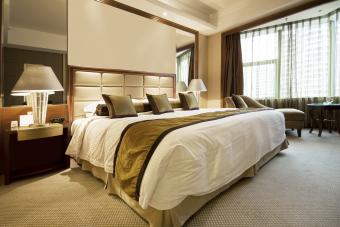
Oilcloth tablecloths offer a sense of nostalgia. Easy to spread over a picnic table or kitchen table, these coverings are functional while providing vintage-inspired flair.
History of Oilcloth Tablecloths
Oilcloths were first created for use on the floors of eighteenth century English homes as rugs. They were also used as coverings for leaky roofs. Artisans stretched sheets of linen cloth on a frame and through a sizing process the cloth was prepared to be painted. This was the point where the oilcloths came to life and were transformed. Various designs evolved as artisans experimented with this new utilitarian artform. After the design was painted onto the cloth, it was sealed with coats of linseed oil.
This artform traveled across the Atlantic Ocean to America, where it was used to grace the floors of Colonial homes. Eventually, as the textile industry grew, the floorcloths were replaced with yarn rugs and the oilcloths eventually found their way onto tables.
Modern Oilcloth
While the traditional linseed oilcloth is no longer produced, the modern versions are just as serviceable, and in most cases, the tablecloth is a better quality product. Today's oilcloth is made out of vinyl that is printed with various colorful designs. The vinyl is then adhered to a cotton mesh backing to give it support and form. Some of the backings used are flannel cotton, very similar to the kind used on vintage tablecloths. Some fabrics use PVC (Poly Vinyl Chloride) for the top side of the fabric and a mixture of polyester and cotton mesh for the backing.
Outdoor Use of Tablecloths
Oilcloth coverings for tables make outdoor dining more versatile and easier to cleanup once the meal is over. Since the vinyl tablecloth is very weather resistant, it won't crack or fade in the harsh summer sun. The properties of the vinyl material mean that if you forget and leave your tablecloth out in the rain, the fabric won't be harmed by the elements. You can even find some tablecloths with weighted hemlines that ensure you won't be bothered by the wind lifting the tablecloth off of the table during your outdoor meal. With this type of design, you won't spend the majority of your meal strategically placing bowls and other objects to weight down the cloth against a gusty summer evening breeze.
Easy Clean-up and Care
Just like the oilcloths your ancestors used, modern tablecloths are easy to clean. If your child spills her drink, the liquid will roll right off of the cloth and all you need do is wipe down the tablecloth with a wet sponge, cloth or paper towel. Never wash your tablecloth in a washing machine or attempt to put in a dryer.
Another added benefit of this type of tablecloth is its stain-resistant property against food or beverage spills. The cloth can also serve as a great surface for kids' hobby projects. The material is versatile enough that if you need a floor cloth for your baby or toddler to play on, then you can easily commandeer the tablecloth to pull double duty.
Authentic Vintage Prints and Patterns

If you want to go with a traditional vintage pattern for your tablecloth then you can find quite a few shops that carry vintage patterns for all kinds of home textiles for tablecloths and even vintage bedspreads. While you may be able to purchase tablecloths made out of authentic oilcloth, you should be aware that some fabrics might contain chemicals that certain states have outlawed as having cancer-causing properties. Some of these cloths may also suffer from surface cracks in the top coating, which make them unpleasant to use and impossible to sanitize. Retro Planet is one shop that carries vintage oilcloth table coverings.
Oilcloth Vintage Patterns in Modern Vinyl
Go for the nostalgic look of vintage tablecloths but made out of modern materials. You can find quite a few ready-made tablecloths that reproduce the beloved vintage patterns. The red gingham pattern is probably the most readily recognized oilcloth pattern and is available in just about any color you could want. The next and probably most popular styles that were used on kitchen tables during the 1930s and 1940s are the fruit patterns. Vivid colors were used in the creation of a variety of patterns ranging from bowls of pears, cherries, apples, oranges, pineapples, and strawberries to individual fruit patterns. Floral designs often featured the standard favorite sunflower or colorful flower bouquets. Check these shops for modern reproductions of these vintage cloths:
A Touch of French-Inspired Romance
If you want something non-traditional and romantic, then you may decide to go with one of the many designs that mimic expensive French table linens. These vinyl tablecloths are rich in color and have intricate designs without the cost of fine linens. They also have the durability that you can only receive from an oilcloth-styled tablecloth. French Rendezvous carries these types of table linens.
Make Your Own Tablecloth
You may want to use the same pattern oilcloth for other projects. Perhaps you want to create matching placemats, a shopping bag or a truly protective apron. You may have a hard-to-fit tabletop that makes sewing a custom-sized tablecloth the only solution for non-standard dimensions. Whatever the reason that you prefer to purchase the actual fabric, you can find a wide range of patterns, colors and designs. You can find a plethora of fabrics that to use in creating your own tablecloths at retailers such as the following:
While the first image that may come to mind when you think about an oilcloth tablecloth is a picnic table, you can find this style of tablecloth to fit a round, square or rectangle table. You may find it difficult to choose just one pattern and end up with a couple of fun designs.







